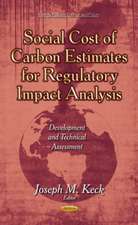Hydrostatic Testing, Corrosion, and Microbiologically Influenced Corrosion: A Field Manual for Control and Prevention
Autor Reza Javaherdashti, Farzaneh Akvanen Limba Engleză Hardback – mar 2017
Preț: 1101.28 lei
Preț vechi: 1343.02 lei
-18% Nou
Puncte Express: 1652
Preț estimativ în valută:
210.73€ • 220.58$ • 175.39£
210.73€ • 220.58$ • 175.39£
Carte tipărită la comandă
Livrare economică 31 martie-14 aprilie
Preluare comenzi: 021 569.72.76
Specificații
ISBN-13: 9781138060067
ISBN-10: 1138060062
Pagini: 90
Dimensiuni: 138 x 216 x 6 mm
Greutate: 0.23 kg
Ediția:1
Editura: CRC Press
Colecția CRC Press
ISBN-10: 1138060062
Pagini: 90
Dimensiuni: 138 x 216 x 6 mm
Greutate: 0.23 kg
Ediția:1
Editura: CRC Press
Colecția CRC Press
Cuprins
A Review of Essentials of Corrosion Needed to Assess Hydrotesting. Microbiology of Corrosion. Assessment Procedure. Closing Remarks. Abbreviations. Annex 1: MIC Risk Factors and Their Relative Weights. Annex 2: A list of Biocides and Their Pros and Cons.
Notă biografică
Reza Javaherdashti, PhD, holds a double degree in materials science and metallurgical engineering. He has more than 20 years of industrial and academic experience. In addition to various research papers and root cause analysis reports, Dr. Javaherdashti has authored several reference books on corrosion. He is an American Society of Mechanical Engineers (ASME)-approved trainer and has designed and executed many international industrial workshops. Furthermore, he has been involved in many consulting and problem-solving activities around the globe and is also a corrosion advisor to internationally renowned companies. Dr. Javherdashti is a veteran member of various well-reputed international corrosion societies such as the National Association of Corrosion Engineers (NACE).
Farzaneh Akvan has a background in physical chemistry and electrochemistry. She holds an MSc degree, and her interests include corrosion management, chemical management, and electrochemistry and its application in corrosion control. She was selected as the Best Young Researcher in Europe in 2010 for her research on cathodic disbondment (she received the award from the Gubkin Russian State University of Oil and Gas). Akvan has worked at the internationally renowned company SGS as a senior officer for inspection of chemicals and materials. In addition to industrial experience, she is also a long-standing member of the Iranian Young Researchers and Elite Club. Akvan has served as executive manager for the Iranian Corrosion Association. She is currently working as a consultant to the oil and gas industries as a senior inspector and corrosion advisor and as a lecturer on the management of the chemicals used for water treatment and corrosion. She has authored several publications on corrosion management and the link between future studies and corrosion management. Akvan is also a member of the International Electrochemistry Society.
Farzaneh Akvan has a background in physical chemistry and electrochemistry. She holds an MSc degree, and her interests include corrosion management, chemical management, and electrochemistry and its application in corrosion control. She was selected as the Best Young Researcher in Europe in 2010 for her research on cathodic disbondment (she received the award from the Gubkin Russian State University of Oil and Gas). Akvan has worked at the internationally renowned company SGS as a senior officer for inspection of chemicals and materials. In addition to industrial experience, she is also a long-standing member of the Iranian Young Researchers and Elite Club. Akvan has served as executive manager for the Iranian Corrosion Association. She is currently working as a consultant to the oil and gas industries as a senior inspector and corrosion advisor and as a lecturer on the management of the chemicals used for water treatment and corrosion. She has authored several publications on corrosion management and the link between future studies and corrosion management. Akvan is also a member of the International Electrochemistry Society.
Recenzii
"This book offers the best available guidance on how to avoid microbially influenced corrosion in pipelines and similar equipment. The authors also provide very useful information on locations within complex equipment where corrosion problems are to be expected. This is very useful information for anyone planning on conducting hydrostatic testing programs or dealing with the corrosion problems associated with improper controls of these operations."
—Bob Heidersbach, Dr. Rust, Inc., Cape Canaveral, Florida, USA
"The book is very useful for professionals to be aware of some neglected issues and their consequences."
—Abdelkader Meroufel, Saline Water Conversion Corporation, Saudi Arabia
"A good introduction of Microbiologically Influenced Corrosion (MIC) to engineers working with hydrostatic testing. It provides a rational and systematic way to detect and deal with potential MIC."
—Johannes Johansson, Swedish Nuclear Fuel and Waste Management Company, Stockholm, Sweden
—Bob Heidersbach, Dr. Rust, Inc., Cape Canaveral, Florida, USA
"The book is very useful for professionals to be aware of some neglected issues and their consequences."
—Abdelkader Meroufel, Saline Water Conversion Corporation, Saudi Arabia
"A good introduction of Microbiologically Influenced Corrosion (MIC) to engineers working with hydrostatic testing. It provides a rational and systematic way to detect and deal with potential MIC."
—Johannes Johansson, Swedish Nuclear Fuel and Waste Management Company, Stockholm, Sweden
Descriere
This field manual covers the conditions that can lead to corrosion failure associated with overlooking corrosion factors pertaining to hydrotesting and offers solutions. It discusses how a test liquid must be selected, corrosion by bacteria ought to be controlled, and the possibility of leakage can be eliminated. It helps the reader evaluate the quality of a hydrotest already conducted and explains tasks that top and middle management must take care of. It discusses MIC as the main corrosion mechanism related to hydrotesting and how to combat this process.

























